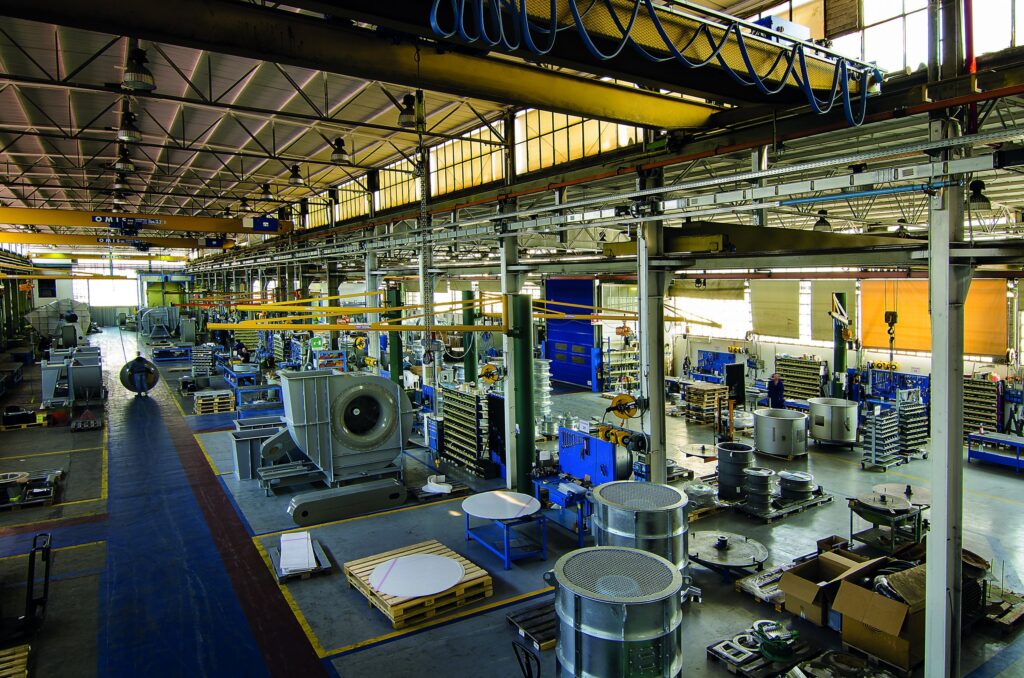Industrial fans play a crucial role in the transportation industry by ensuring proper ventilation, cooling, air filtration, and fume extraction in various transportation infrastructures and vehicles. From underground tunnels to large-scale transit systems, these fans contribute to safety, efficiency, and environmental control. Below is a detailed look at how industrial fans are applied in different areas of transportation.
1. Tunnel Ventilation and Air Quality Control
Tunnels, whether for roadways, railways, or subways, require extensive ventilation systems to maintain air quality and remove harmful gases. Industrial fans are essential in keeping tunnels safe and breathable.
-
Jet Fans (Impulse Fans): Used in long road and railway tunnels to control airflow and direct fumes toward exhaust shafts.
-
Axial Ventilation Fans: Provide continuous fresh air circulation to dilute exhaust emissions from vehicles.
-
Emergency Smoke Extraction Fans: Help remove smoke and toxic gases in case of fire or accidents, improving visibility and allowing safe evacuation.
2. Subway and Train Station Ventilation
Subways and train stations experience high passenger density and require effective ventilation to manage air quality, humidity, and temperature.
-
Platform Screen Door Fans: Ensure fresh air exchange between platforms and tunnels, reducing heat buildup.
-
Subway Tunnel Ventilation Fans: Extract hot air generated by trains and improve air circulation within tunnels.
-
Cooling Fans for Train Stations: Regulate indoor temperatures in waiting areas, preventing heat accumulation during peak hours.
3. Bus and Truck Manufacturing Facilities
Manufacturing plants for buses, trucks, and other commercial vehicles require proper air movement for worker safety and production efficiency.
-
Paint Booth Fans: Control airflow in painting areas to remove overspray, improve drying times, and ensure an even coat.
-
Dust Collection Fans: Help filter out dust and particles in fabrication areas where cutting, welding, and grinding take place.
-
Welding Fume Extractors: Capture hazardous fumes and airborne contaminants generated during vehicle assembly.
4. Aircraft Hangars and Airports
Industrial fans are widely used in airports and aircraft hangars for ventilation, cooling, and smoke control.
-
Large HVLS (High-Volume, Low-Speed) Fans: Provide efficient airflow in massive hangars to regulate temperature and reduce condensation.
-
Jet Engine Test Cell Fans: Extract exhaust gases and cool engine testing areas.
-
Smoke and Fire Control Fans: Essential for emergency smoke evacuation in terminal buildings and aircraft maintenance areas.
5. Shipbuilding and Marine Transportation
Shipyards and vessels require industrial fans for air circulation, cooling, and hazardous gas removal.
-
Marine Ventilation Fans: Maintain fresh air supply in engine rooms, cargo holds, and crew quarters.
-
Dehumidification Fans for Cargo Ships: Prevent moisture buildup that could damage goods and ship structures.
-
Exhaust Fans for Diesel Engines: Extract combustion gases from ship engine rooms to ensure worker safety.
6. Parking Garage Ventilation
Enclosed parking garages, whether underground or multi-level, require ventilation systems to remove harmful vehicle emissions such as carbon monoxide and nitrogen dioxide.
-
CO Exhaust Fans: Detect and remove carbon monoxide buildup from car exhaust emissions.
-
Jet Thrust Fans: Improve air circulation by pushing vehicle exhaust toward exhaust vents.
-
Fire and Smoke Exhaust Fans: Provide emergency ventilation in case of a fire, clearing smoke for safe evacuation.
7. Automotive Cooling and Air Filtration
Automobiles, trucks, and other vehicles rely on industrial fans for various cooling and air filtration functions.
-
Radiator Cooling Fans: Regulate engine temperature by drawing cool air through radiators.
-
Cabin Air Filtration Fans: Maintain air quality inside vehicles by filtering out pollutants and allergens.
-
Brake Cooling Fans: Used in high-performance and heavy-duty vehicles to prevent brake overheating.
8. Rail Freight and Cargo Transportation
Rail freight systems require industrial fans to maintain safe conditions for both goods and personnel.
-
Refrigerated Cargo Fans: Ensure proper temperature control for perishable goods transported by rail.
-
Locomotive Cooling Fans: Help regulate engine temperature and prevent overheating.
-
Tunnel Exhaust Fans for Freight Trains: Remove diesel fumes and maintain air quality in rail tunnels.
9. Ports and Freight Terminals
Industrial fans are crucial in managing air quality, humidity, and temperature in logistics hubs such as shipping ports, freight terminals, and warehouses.
-
Container Ventilation Fans: Prevent moisture buildup inside shipping containers, reducing the risk of cargo damage.
-
Warehouse Cooling Fans: Improve air circulation in freight storage areas, ensuring goods are stored under proper conditions.
-
Exhaust Fans in Customs Inspection Areas: Remove fumes from scanning equipment and vehicle inspections.
Conclusion
Industrial fans are indispensable in the transportation industry, enhancing air quality, safety, and efficiency in tunnels, stations, airports, vehicle manufacturing, and cargo transport. Their ability to control ventilation, remove contaminants, and manage temperature makes them essential for both infrastructure and vehicle applications. By integrating the right types of fans into transportation systems, operators can ensure better air quality, compliance with safety regulations, and improved operational efficiency.

